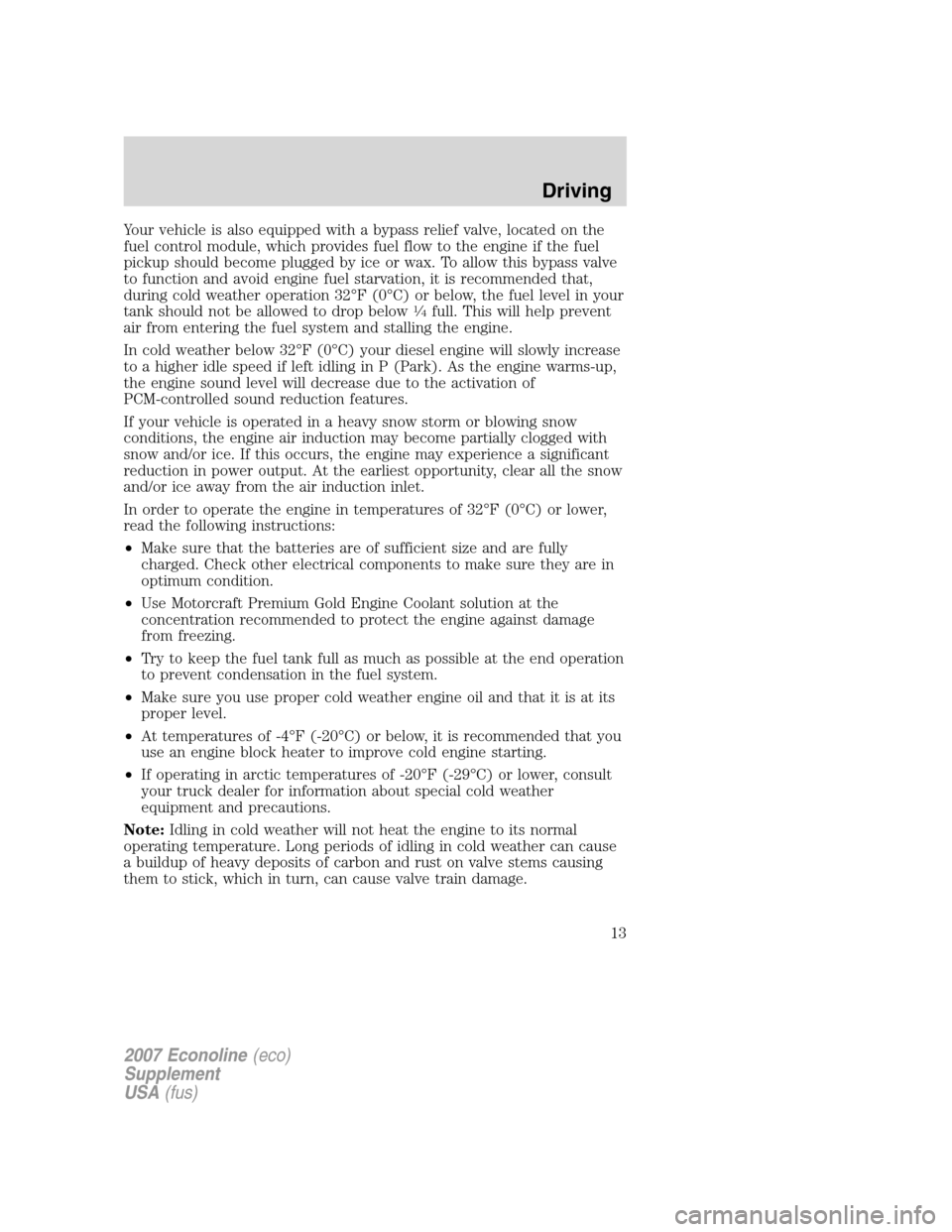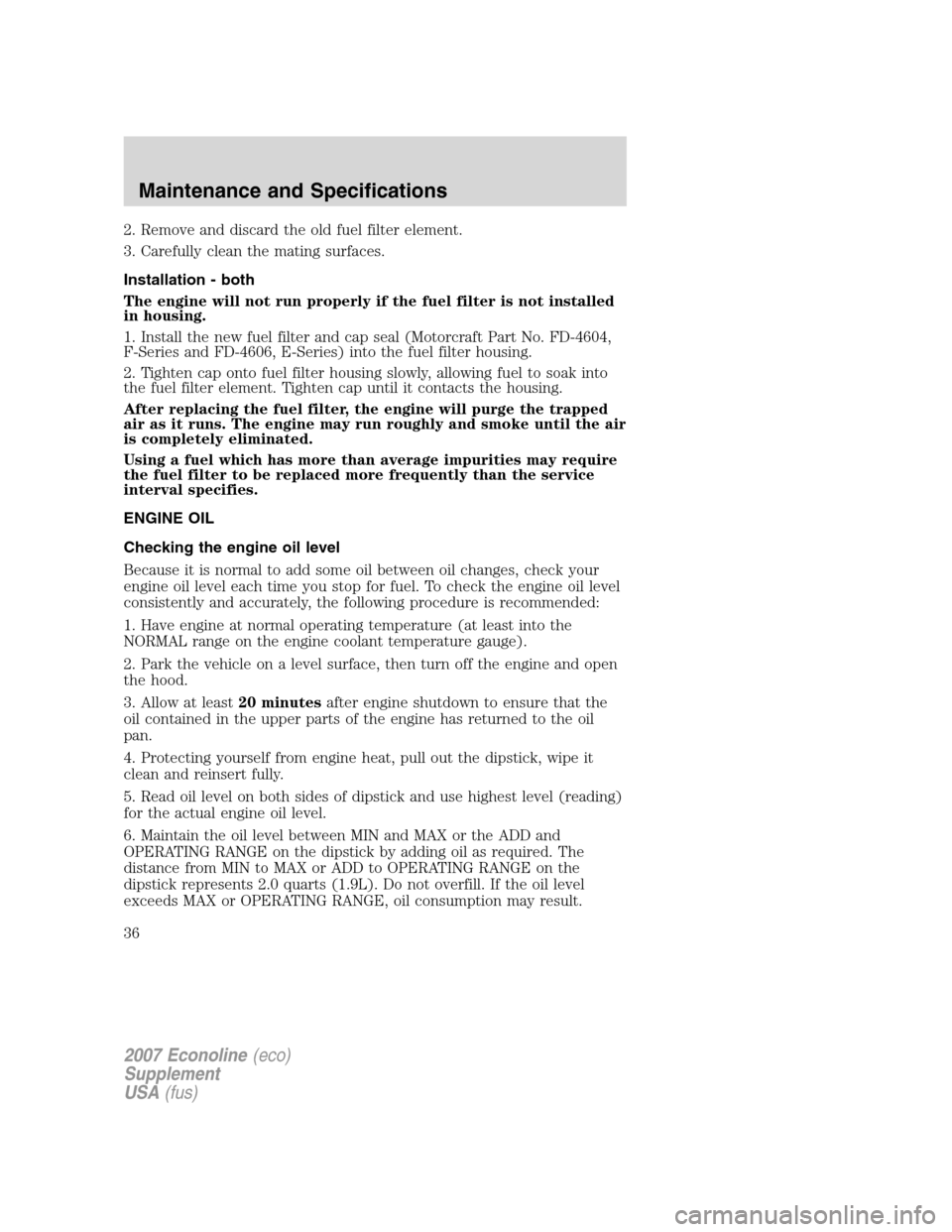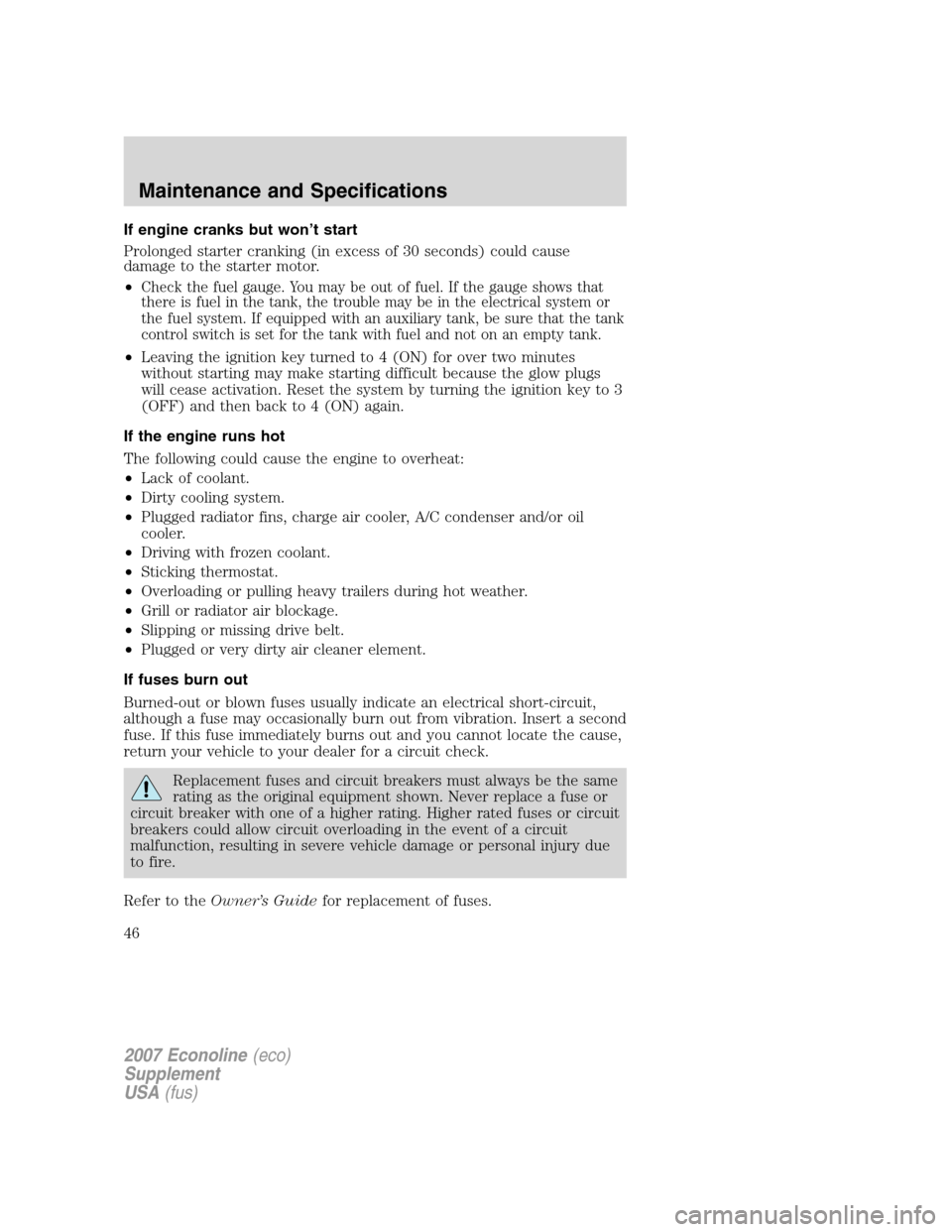Page 1 of 72
Introduction
2
Instrument Cluster
6
Driving
11
Roadside emergencies
19
Cleaning
25
Maintenance and Specifications
27
Scheduled Maintenance Guide
49
Normal scheduled maintenance and log 54
Exceptions 62
Special operating conditions and log 63
Motorcraft Premium Gold Coolant change record 68
All rights reserved. Reproduction by any means, electronic or mechanical
including photocopying, recording or by any information storage and retrieval
system or translation in whole or part is not permitted without written
authorization from Ford Motor Company. Ford may change the contents without
notice and without incurring obligation.
Copyright © 2006 Ford Motor Company
Table of Contents
1
2007 Econoline(eco)
Supplement
USA(fus)
Page 13 of 72

Your vehicle is also equipped with a bypass relief valve, located on the
fuel control module, which provides fuel flow to the engine if the fuel
pickup should become plugged by ice or wax. To allow this bypass valve
to function and avoid engine fuel starvation, it is recommended that,
during cold weather operation 32°F (0°C) or below, the fuel level in your
tank should not be allowed to drop below
1�4full. This will help prevent
air from entering the fuel system and stalling the engine.
In cold weather below 32°F (0°C) your diesel engine will slowly increase
to a higher idle speed if left idling in P (Park). As the engine warms-up,
the engine sound level will decrease due to the activation of
PCM-controlled sound reduction features.
If your vehicle is operated in a heavy snow storm or blowing snow
conditions, the engine air induction may become partially clogged with
snow and/or ice. If this occurs, the engine may experience a significant
reduction in power output. At the earliest opportunity, clear all the snow
and/or ice away from the air induction inlet.
In order to operate the engine in temperatures of 32°F (0°C) or lower,
read the following instructions:
•Make sure that the batteries are of sufficient size and are fully
charged. Check other electrical components to make sure they are in
optimum condition.
•Use Motorcraft Premium Gold Engine Coolant solution at the
concentration recommended to protect the engine against damage
from freezing.
•Try to keep the fuel tank full as much as possible at the end operation
to prevent condensation in the fuel system.
•Make sure you use proper cold weather engine oil and that it is at its
proper level.
•At temperatures of -4°F (-20°C) or below, it is recommended that you
use an engine block heater to improve cold engine starting.
•If operating in arctic temperatures of -20°F (-29°C) or lower, consult
your truck dealer for information about special cold weather
equipment and precautions.
Note:Idling in cold weather will not heat the engine to its normal
operating temperature. Long periods of idling in cold weather can cause
a buildup of heavy deposits of carbon and rust on valve stems causing
them to stick, which in turn, can cause valve train damage.
2007 Econoline(eco)
Supplement
USA(fus)
Driving
13
Page 27 of 72
IDENTIFYING COMPONENTS IN THE ENGINE COMPARTMENT
E-Series
1. Windshield washer fluid reservoir
2. Automatic transmission dipstick
3. Engine oil filler cap
4. Secondary fuel filter assembly (out of view)
5. Power steering fluid reservoir
6. Brake fluid reservoir
7. Engine coolant reservoir
8. Air filter assembly
9. Engine oil dipstick
10. Power distribution box
The Fuel Conditioner Module (FCM) is located on the driver-side of the
vehicle next to the transmission case.
2007 Econoline(eco)
Supplement
USA(fus)
Maintenance and Specifications
27
Page 28 of 72
F-Super Duty
1. Automatic transmission dipstick (if equipped)
2. Engine oil fill
3. Engine oil filter
4. Engine-mounted fuel filter assembly
5. Engine coolant reservoir
6. Brake fluid reservoir
7. Clutch fluid reservoir (if equipped)
8. Power distribution box
9. Battery (dual batteries shown)
10. Power steering fluid reservoir
11. Air filter assembly
12. Engine oil dipstick
13. Windshield washer fluid reservoir
2007 Econoline(eco)
Supplement
USA(fus)
Maintenance and Specifications
28
Page 36 of 72

2. Remove and discard the old fuel filter element.
3. Carefully clean the mating surfaces.
Installation - both
The engine will not run properly if the fuel filter is not installed
in housing.
1. Install the new fuel filter and cap seal (Motorcraft Part No. FD-4604,
F-Series and FD-4606, E-Series) into the fuel filter housing.
2. Tighten cap onto fuel filter housing slowly, allowing fuel to soak into
the fuel filter element. Tighten cap until it contacts the housing.
After replacing the fuel filter, the engine will purge the trapped
air as it runs. The engine may run roughly and smoke until the air
is completely eliminated.
Using a fuel which has more than average impurities may require
the fuel filter to be replaced more frequently than the service
interval specifies.
ENGINE OIL
Checking the engine oil level
Because it is normal to add some oil between oil changes, check your
engine oil level each time you stop for fuel. To check the engine oil level
consistently and accurately, the following procedure is recommended:
1. Have engine at normal operating temperature (at least into the
NORMAL range on the engine coolant temperature gauge).
2. Park the vehicle on a level surface, then turn off the engine and open
the hood.
3. Allow at least20 minutesafter engine shutdown to ensure that the
oil contained in the upper parts of the engine has returned to the oil
pan.
4. Protecting yourself from engine heat, pull out the dipstick, wipe it
clean and reinsert fully.
5. Read oil level on both sides of dipstick and use highest level (reading)
for the actual engine oil level.
6. Maintain the oil level between MIN and MAX or the ADD and
OPERATING RANGE on the dipstick by adding oil as required. The
distance from MIN to MAX or ADD to OPERATING RANGE on the
dipstick represents 2.0 quarts (1.9L). Do not overfill. If the oil level
exceeds MAX or OPERATING RANGE, oil consumption may result.
2007 Econoline(eco)
Supplement
USA(fus)
Maintenance and Specifications
36
Page 42 of 72
2. Remove the rear cover (the cover
near the coolant reservoir) from the
filter element by pushing it back
and pulling up to disengage the tabs
on the cover from the slots on the
filter element.
Rear cover tabs must be
disengaged from the slots before
pushing it or damage to the air
cleaner element will occur.
3. Push the cover to the rear under
the coolant reservoir and behind the
slots on the filter element.
4. Remove the front cover from the
filter element by pulling the cover
forward and pulling up to disengage
the tabs on the cover from the slots
on the filter element while pulling
up on the rear of the filter element.
Front cover tabs must be
disengaged from the slots before
pulling it or damage to the air
cleaner element will occur.
2007 Econoline(eco)
Supplement
USA(fus)
Maintenance and Specifications
42
Page 46 of 72

If engine cranks but won’t start
Prolonged starter cranking (in excess of 30 seconds) could cause
damage to the starter motor.
•
Check the fuel gauge. You may be out of fuel. If the gauge shows that
there is fuel in the tank, the trouble may be in the electrical system or
the fuel system. If equipped with an auxiliary tank, be sure that the tank
control switch is set for the tank with fuel and not on an empty tank.
•Leaving the ignition key turned to 4 (ON) for over two minutes
without starting may make starting difficult because the glow plugs
will cease activation. Reset the system by turning the ignition key to 3
(OFF) and then back to 4 (ON) again.
If the engine runs hot
The following could cause the engine to overheat:
•Lack of coolant.
•Dirty cooling system.
•Plugged radiator fins, charge air cooler, A/C condenser and/or oil
cooler.
•Driving with frozen coolant.
•Sticking thermostat.
•Overloading or pulling heavy trailers during hot weather.
•Grill or radiator air blockage.
•Slipping or missing drive belt.
•Plugged or very dirty air cleaner element.
If fuses burn out
Burned-out or blown fuses usually indicate an electrical short-circuit,
although a fuse may occasionally burn out from vibration. Insert a second
fuse. If this fuse immediately burns out and you cannot locate the cause,
return your vehicle to your dealer for a circuit check.
Replacement fuses and circuit breakers must always be the same
rating as the original equipment shown. Never replace a fuse or
circuit breaker with one of a higher rating. Higher rated fuses or circuit
breakers could allow circuit overloading in the event of a circuit
malfunction, resulting in severe vehicle damage or personal injury due
to fire.
Refer to theOwner’s Guidefor replacement of fuses.
2007 Econoline(eco)
Supplement
USA(fus)
Maintenance and Specifications
46
Page 47 of 72
MOTORCRAFT PART NUMBERS
Item Ford Part Number
Engine oil filter FL-2016
Air Filter – Super Duty
14C3Z-9601-AA
Air Filter – E-series1FA-1804
Fuel filter (2 required) FD-4604
Battery (2 Required) BXT-65-750
1Always use the authorized Motorcraft air filter listed.Failure to use
the correct air filter may result in severe engine damage.
REFILL CAPACITIES
Component Capacity
Cooling system127.5 quarts (26.0L)
Engine oil215.0 quarts (14.2L)
Fuel tankRefer to yourOwner’s
Guide
Radiator cap 16 psi (110 kPa)
Manual transmission
35.8 quarts (5.5L)
Automatic transmissionRefer to yourOwner’s
Guide
1Includes heater and 5.0 quarts (4.7L) in coolant recovery.
2Includes 1 quart (1.0L) in engine oil filter.
3Use Motorcraft MERCON�ATF, Motorcraft part number XT-2–QDX,
meeting Ford specification MERCON�.
2007 Econoline(eco)
Supplement
USA(fus)
Maintenance and Specifications
47